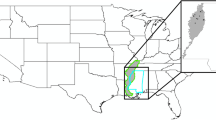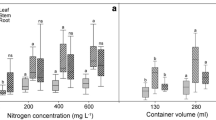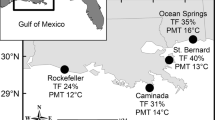Abstract
The loss of Carex dominated meadows due to agricultural drainage in the previously glaciated midcontinent of North America has been extensive. The lack of natural Carex recruitment in wetland restorations and the failures of revegetation attempts underscore the need for information on the establishment requirements of wetland sedges. In this study, seedlings of Carex stricta Lam. were planted in three experimental wetlands in east-central Minnesota, USA to investigate the biotic and abiotic environmental limitations to establishment. Seedlings were planted along an elevational water depth gradient to assess the effects of water depth and water level fluctuation on seedling survival and growth. A different water level fluctuation regime was assigned to each of the experimental wetlands to assess seedling tolerance for seasonal water level changes. The effects of seedling planting density and the presence or absence of non-sedge colonizers on seedling survival and growth were also studied. The experiment was followed for three growing seasons. The results of this study indicate that C. stricta seedlings were sensitive to the timing and duration of inundation during the first growing season. Once established, plants tolerated a broad range of seasonal drying and flooding conditions. Seedling and juvenile growth was slowed by non-sedge colonizers during the first two growing seasons, but by the third growing season, C. stricta was able to out-grow all annual and perennial weeds, except the aggressive perennial, Phalaris arundinacea L. The rapid growth of C. stricta plants, once established, indicates that the use of seedlings is a successful method for (re) introducing this tussock sedge into wetland restorations under a variety of environmental conditions. Comparison with other studies performed under similar conditions suggests that planting of seedlings is a more appropriate method of establishing this species than the use of transplanted rhizomes.
Similar content being viewed by others
References
Alexeev Y.E. 1988. Ontogenesis in Carex species. Aquatic Botany 29: 39–48.
Bakker J.P., Poschlod P., Strykstra R.J., Bekker R.M. and Thompson K. 1989. Seed banks and seed dispersal: important topics in restoration ecology. Acta Bot. Neerl. 45: 461–490.
Baskin C.C., Chester E.W. and Baskin J.M. 1996. Effect of flooding on annual dormancy cycles in buried seeds of two wetland Carex species. Wetlands 16: 84–88.
Bernard J.M. 1990. Life history and vegetative reproduction in Carex. Canadian Journal of Botany 68: 1441–1448.
Bernard J.M. and Gorham E. 1978. Life history aspects of primary production in sedge wetlands.. In: Good R.E., Whigham D.F. and Simpson R.L. _eds_, Freshwater wetlands: production processes and management potential. Academic Press, New York, USA, pp. 39–51.
Budelsky R.A. and Galatowitsch S.M. 1999. Effects of moisture, temperature, and time on seed germination of five wetland Carices: implications for restoration. Restoration Ecology 7: 86–97.
Budelsky R.A. and Galatowitsch S.M. 2000. Effects of water regime and competition on the establishment of a native sedge in restored wetlands. Journal of Applied Ecology 37: 971–985.
Costello D.F. 1936. Tussock meadows in southeastern Wisconsin. Botanical Gazette 97: 610–648.
Crawford R.M.M. 1982. Physiological responses to flooding. In: Lange O.L., Nobel P.S., Osmond C.B. and Ziegler H. _eds_, Physiological Plant Ecology. II. Encyclopedia of Plant Physiology. Vol 12B. Springer-Verlag, New York, USA, pp. 453–477.
Dahl T.E. and Johnson C.E. 1991. Wetland status and trends in the conterminous United States, mid-1970's to mid-1980's. U.S. Fish and Wildlife Service, Washington, DC, USA.
Galatowitsch S.M., Anderson N.O. and Ascher P.D. 1999b. Invasiveness in wetland plants in temperate North America. Wetlands 19: 733–755.
Galatowitsch S.M., Budelsky R.A. and Yetka L.A. 1999a. Revegetation strategies for northern temperate glacial marshes and meadows. In: Streever W. (ed.), An international perspective on wetland rehabilitation. Kluwer Academic Publishers, Dordrecht, Netherlands.
Galatowitsch S.M. and van der Valk A.G. 1994. Restoring prairie wetlands: an ecological approach. Iowa State University Press, Ames, Iowa, USA.
Galatowitsch S.M. and van der Valk A.G. 1996a. Characteristics of recently restored wetlands in the prairie pothole region. Wetlands 16: 75–83.
Galatowitsch S.M. and van der Valk A.G. 1996b. The vegetation of restored prairie pothole wetlands. Ecological Applications 6: 102–112.
Garwood A.N. 1996. Weather America: the latest detailed climatological data for over 4,000 places – with rankings. Toucan Valley Publications Inc., Milpitas, California, USA.
Gleason H.A. and Cronquist A. 1991. Manual of vascular plants of Northeastern United States and adjacent Canada, 2nd ed. The New York Botanical Garden, New York, USA.
Green E.M. and Galatowitsch S.M. 2001. Differences in wetland plant community establishment with additions of nitrate-N and invasive species _Phalaris arundinacea and Typha x glauca_. Canadian Journal of Botany 79: 170–178.
Green E.M. and Galatowitsch S.M. 2002. Effects of Phalaris arundinacea and nitrate-N addition on wetland plant community establishment. Journal of Applied Ecology. 39(1): 134–144.
Harper J.L. 1977. Population biology of plants. Academic Press, London, UK.
Harris S.W. and Marshall W.H. 1963. Ecology of water level manipulation on a northern marsh. Ecology 44: 331–343.
Isselstein J., Tallowin J.R.B. and Smith R.E.N. 2002. Factors affecting seed germination and seedling establishment of fen-meadow species. Restoration Ecology 10 (2): 173–184.
Johnstone I.M. 1986. Plant invasion windows: a time-based classification of invasion potential. Biological Review 61: 369–394.
Keddy P.A. and Ellis T.H. 1985. Seedling recruitment of eleven wetland plant species along a water level gradient: shared or distinct responses? Canadian Journal of Botany 63: 1867–1879.
Kirkman L.K. and Sharitz R.R. 1993. Growth in controlled water regimes of three grasses common in freshwater wetlands of the southeastern USA. Aquatic Botany 44: 345–359.
Kleinschmidt C. and Rosenthal G. 1995. Seedbank potential and seed dispersal in inundated damp meadows. Kieler notes to the Botany in Schleswig-Holstein and Hamburg 23: 40–44.
Lehman C.L. 2000. The competition-colonization equations: ecological and evolutionary implications. PhD. Dissertation. University of Minnesota, St. Paul, Minnesota, USA.
McKee K.L., Mendelssohn I.A. and Burdick D.M. 1989. Effect of long-term flooding on root metabolic response in five freshwater marsh plant species. Canadian Journal of Botany 67: 3446–3452.
Meeks R.L. 1969. The effect of drawdown date on wetland plant succession. Journal of Wildlife Management 33: 817–821.
Millar J.B. 1973. Vegetation changes in shallow marsh wetlands under improving moisture regime. Canadian Journal of Botany 51: 1443–1457.
Montgomery D.C. 1991. Design and analysis of experiments, 3rd ed. John Wiley and Sons, New York, USA.
Mueller-Dombois D. and Ellenberg H. 1974. Aims and methods of vegetation ecology. John Wiley and Sons, New York, USA.
Mulhouse J. and Galatowitsch S. 2003. Revegetation of prairie pothole wetlands in the mid-continental US: twelve years post-flooding. Plant Ecology 169(1): 143–159.
Perry L.G. 2001. Controlling Phalaris arundinacea invasion in re-stored sedge meadow wetlands. Ph.D. Dissertation. University of Minnesota. Minneapolis, Minnesota, USA.
Pfadenhauer J. and Grootjans A. 1999. Wetland restoration in Central Europe: aims and methods. Applied Vegetation Science 2: 95–106.
Pfadenhauer J. and Mass D. 1987. Samenpotential in Niedermoor-böden des Alpenvorlandes bei Grünlandnutzung unterschiedli-cher Intensität. Flora 179: 85–97.
Phillips M.M. 1993. Wetland plant communities and factors influencing plant distributions at the Cedar Creek Natural History Area, Minnesota. Ph.D. Dissertation. University of Minnesota, Minneapolis, Minnesota, USA.
Prince H. 1997. Wetlands of the American midwest: a historical geography of changing attitudes. University of Chicago Press, Chicago, Illinois, USA.
Roelofs J.G.M., Bobbink R., Brouwer E. and de Graaf M.C.C. 1996. Restoration ecology of aquatic and terrestrial vegetation on non-calcareous soils in The Netherlands. Acta Bot. Neerl. 45: 517–541.
Roth S., Seeger T., Poschlod P., Pfadenhauer J. and Succow M. 1999. Establishment of helophytes in the course of fen restoration. Applied Vegetation Science 2: 131–136.
SAS Institute, Inc. 1996. SAS System for Microsoft Windows, Release 6. 12. Cary, North Carolina, USA.
Shipley B., Keddy P.A. and Lefkovitch L.P. 1991. Mechanisms producing plant zonation along a water depth gradient: a comparison with the exposure gradient. Canadian Journal of Botany 69: 1420–1424.
Shipley B., Keddy P.A., Moore R.J. and Lemky K. 1989. Regeneration and establishment strategies of emergent macrophytes. Journal of Ecology 77: 1093–1110.
Sjoberg K. and Danell K. 1983. Effects of permanent flooding on Carex-Equisetum wetlands in northern Sweden. Aquatic Botany 15: 275–286.
Spence D.H.N. 1982. The zonation of plants in freshwater lakes.. In: Macfadyen A. and Ford E.D. _eds_, Advances in ecological research. Academic Press, New York, USA.
Squires L. and van der Valk A. G. 1992. Water-depth tolerances of the dominant emergent macrophytes of the Delta Marsh, Mani-toba. Canadian Journal of Botany 70: 1860–1867.
Tilman D., May R.M., Lehman C.L. and Nowak M.A. 1994. Habitat destruction and the extinction debt. Nature 371: 65–66.
van der Valk A.G. 1981. Succession in wetlands: a Gleasonian approach. Ecology 62: 688–696.
van der Valk A.G. 1982. Succession in temperate North American wetlands.. In: Gopal B., Turner R.E., Wetzel R.G. and Whigham D.F. _eds_, Wetlands: ecology and management. Jaipur: International Scientific Publications, India, pp. 169-179.
van der Valk A.G. 2000. Vegetation dynamics and models. In: Murkin H.R., van der Valk A.G. and Clark W.R. _eds_, Prairie wetland ecology: the contribution of the Marsh Ecology Research Program. Iowa State University Press, Ames, Iowa, USA, pp. 125-161.
van der Valk A.G., Bremolm T.L. and Gordon. E. 1999. The restoration of sedge meadows: seed viablity, seed germination requirements and seedling growth of Carex species. Wetlands 19: 756–764.
van der Valk A.G., Pederson R.L. and Davis C.B. 1992. Restoration and creation of freshwater wetlands using seedbanks. Wetlands Ecology and Management 1: 191–197.
van der Valk A.G. and Verhoven J.T.A. 1988. Potential role of seedbanks and understory species in restoring quaking fens from floating forests. Vegetatio 76: 3–13.
van der Valk A.G. and Welling C.H. 1988. The development of zonation in freshwater wetlands: an experimental approach. In: During H.J., Werger M.J.A. and Willems J.H. _eds_, Diversity and pattern in plant communities. SPB Academic Publishing. The Hague, Netherlands, pp. 145-158.
Welling C.H., Pederson R.L. and van der Valk A.G. 1988. Recruitment from the seed bank and the development of zonation of emergent vegetation during a drawdown in a prairie wetland. Journal of Ecology 76: 483–496.
Werner K.J. and Zedler J.B. 2002. How sedge meadow soils, microtopography, and vegetation respond to sedimentation. Wetlands 22(3): 451–466.
Wheeler G. A. 1981. A study of the genus Carex in Minnesota. Vol. 2. Ph.D. Dissertation. University of Minnesota, Minneapolis, Minnesota, USA.
Wienhold C.E. and van der Valk A.G. 1989. The impact of duration of drainage on the seedbanks of northern prairie wetlands. Canadian Journal of Botany 67: 1878–1884.
Wilcox D.A., Apfelbaum S.I. and Hiebert R.D. 1985. Cattail invasion of sedge meadows following hydrologic disturbance in the Cowles Bog wetland complex, Indiana Dunes National Lake-shore. Wetlands 4: 115–128.
Wilson S.D. and Keddy P.A. 1986. Plant zonation on a shoreline gradient: physiological response curves of component species. Journal of Ecology 73: 851–860.
Yetka L.A. and Galatowitsch S.M. 1998. Factors affecting revegetation of Carex lacustris Willd. and Carex stricta Lam. from rhizomes. Restoration Ecology 7: 86–97.
Author information
Authors and Affiliations
Rights and permissions
About this article
Cite this article
Budelsky, R.A., Galatowitsch, S.M. Establishment of Carex stricta Lam. seedlings in experimental wetlands with implications for restoration. Plant Ecology 175, 91–105 (2004). https://doi.org/10.1023/B:VEGE.0000048102.72101.50
Issue Date:
DOI: https://doi.org/10.1023/B:VEGE.0000048102.72101.50




